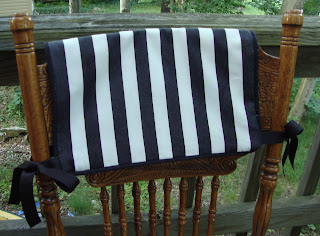Do you want an easy, fun, fairly inexpensive way to brighten your living space? Throw pillows are great! You can add a cover to an existing pillow in about an hour, and change the look of your room. This is the Envelope style cover. No zippers needed.
Here's the info: You need a sewing machine, zipper foot, fabric, scissors, rotary cutter, ruler and mat (optional) thread and trim, if desired. The amount of fabric and trim depends on the size of the pillow. I'm making covers for 19" square pillows, so I have 3/4 yard of 54" wide fabric, and 2 1/4 yards of piping. If your fabric is 45" wide, you'll need 1 1/4 yards. For two pillows, you'll need 1 7/8 yards.
Measure your pillow, add 1/2" to each side (1 inch total). So, for a 19" finished cover, I need 20" of fabric. I make sure my fabric is straight and even, and cut a 20" by width of fabric (WOF). I then cut off the selvage on one side, and cut a 20" square, plus 2 15" by 20" rectangles. Smaller pillow sizes need thinner rectangles, An 18" would be 13" by 18.
First, finish the edge of one side of the rectangle, the 20" side, not the short side. I use my serger first, to finish the edge, then roll it and stitch it. If you don't have a serger, you can press in 1/4" and press it in again, and stitch. I do have a rolled hem foot that does the same thing, but it's a smaller hem, and this fabric is thick, so it was easier to just use my regular foot. Do both rectangles, only one edge each.
Switch to your zipper foot, and determine where 1/2: seam allowance is. Place the fabric edge along this line, and baste on your piping trim. Put the trim right sides down on the right side of the fabric, with the 'bump" of the piping towards the center, and the raw edges together. This piping was thin, so the seam allowance is less than 1/2", so the edges don't meet, but the stitching line on the piping is along the 1/2" seam line. I'm going to overlap the ends, rather than connecting them, so I start in the center, with a little curve up to the stitching line.
When you get to a corner, snip the piping seam allowance where you will turn. Don't snip past the stitching line on the piping. Create a little fold in the piping, and pivot around the corner, lining up the piping along the next edge. Continue for all 4 corners.
Overlap the ends, curving the end down after it crosses the beginning piece.
Trim the thread and cut the extra piping (I usually do it even with the fabric edge.)
Now, lay your pillow front, right sides up on a flat surface. Lay one of the rectangles right side down, with the finished edge towards the middle, and the raw edges matching. Lay the second rectangle over that, on the opposite side, again matching raw edges. They should overlap in the middle.
Pin the overlap edges to hold them in place, then add a few more pins to keep it together.
HINT!! Move your needle 2 steps LEFT from where you basted the piping. It helps to hide the stitches on the piping and gets you a little closer to the bump. The pillow looks better! Trying to get closer to the bump is important. The foot will push away from this, so I actually steer more right, so it actually looks like I'm not sewing straight, but it keeps it closer to the piping.
Stitch around all 4 sides, backstitching where the overlaps begin and end.
Notice the needle is more to the left from the basting stitches for the piping.
I like to serge these edges, just to prevent fraying. That's optional. You can also use pinking shears, if you have them.
Trim the corners, turn right side out, and press. Insert pillow and TADAAH! You have a new look!
Sorry, I don't have the pillow body to show you the finished pillow. This is the back. Any fabric can be used, but make sure you have the design going the same way, if using certain prints. If using a quilted square, prepare the front as you wish (quilted, embelished, etc) and trim to the size plus 1/2" for the seams. Cut your back fabric, and finish as above.
Want something a little different? What about a flange?? That's the outer flat edge on some decorative pillows. It makes the pillow seem larger, but it's only extra fabric. Add 4" to your cut measurements. For example, cut a 24" square for the front, and it will hold my 19" pillow. Cut the2 back rectangles 24 by 17". Follow the above directions, turn and press. Topstitch 2 inches away from piping through all the layers, around the whole pillow. It looks like a frame. Press again (the stitches look better!) and insert the pillow. You have a nice flange edged pillow.
Let me know if you make any pillows using these directions! I'll be making 6 in total this time, for a customer. I do plan to make a few new ones for my living room. It's also a great way to use an extra quilt block. Add a frame to make it the size you need, quilt it, and add a cute accent to your bed!




























